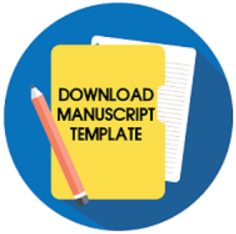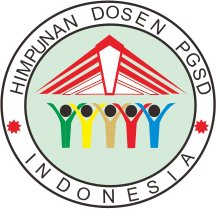PENGARUH PENGGUNAAN MEDIA FILM ANIMASI TERHADAP KETERAMPILAN MENULIS KARANGAN NARASI SISWA KELAS V SD
Downloads
Penelitian ini bertujuan untuk mengetahui pengaruh penggunaan media film animasi terhadap keterampilan menulis karangan narasi siswa kelas V SD. Jenis penelitian ini adalah quasi experiment dengan desain pretest-posttest control group desain. Hasil penilaian menunjukkan kelompok kontrol memperoleh rata-rata skor pretes 27,92 dan postes 29,51, kelompok eksperimen I memperoleh rata-rata skor pretes 27,95 dan postes 31,73, sedangkan kelompok eksperimen II memperoleh rata-rata skor pretes 27,75 dan postes 31,33. Peningkatan rata-rata skor yang diperoleh kelompok kontrol sebesar 1,59. Peningkatan rata-rata skor kelompok eksperimen I sebesar 3,78 dan peningkatan rata-rata skor kelompok eksperimen II sebesar 3,58. Hasil uji t kelompok kontrol dan kelompok eksperimen I diketahui nilai signifikansi 0,000 < 0,05. Hasil uji t kelompok kontrol dan kelompok eksperimen II menunjukkan nilai signifikansi 0,000 < 0,05. Hasil Anova menunjukkan nilai signifikansi 0,000 < 0,05. Dari data tersebut dapat disimpulkan terdapat pengaruh penggunaan media film animasi terhadap keterampilan menulis karangan narasi siswa kelas V SD.
EFFECTS OF THE USE OF ANIMATION FILM MEDIA ON THE NARRATIVE TEXT WRITING SKILL OF GRADE V STUDENTS OF ESs
ABSTRACT
This study is to find out the effects of the use of animation film media on the narrative text writing skill of Grade V students of elementary schools (ESs). This study was a quasi-experimental employing the pretest-posttest control group design. The results of the study show the control group attained a pretest mean score of 27.92 and a posttest mean score of 29.51; experimental group I attained a pretest mean score of 27.95 and a posttest mean score of 37.73 while experimental group II attained a pretest score of 27.75 and a posttest mean score 31.33. The mean gain score attained by the control group was 1.59. The mean gain score attained by experimental group I was 3.78, and that by experimental group II was 3.58. The results of the t-test for the control group and experimental group I showed a significance value of 0.000 < 0.05. The results of the t-test for the control group and experimental group II show a significance value of 0.000 < 0.05. The result of ANOVA shows a significance value of 0.000 < 0.05. Based on the data, it can be concluded that there are effects of the use of animation film media on the narrative text writing skill of Grade V students of ESs.
Keywords: animation film media, text writing skillDownloads
Browne, A. (2009). Developing language and literacy 3-8. (3rd ed.). London: SAGE Publications Ltd.
Chee, T. S. & Wong, A. F. L. (2003). Teaching and learning with technology: An asia-pacific perspective. Lok Yang: Prentice Hall
Kemdiknas. (2008). Peraturan Menteri Pendidikan Nasional Nomor 23, Tahun 2006, tentang Standar Isi Untuk Satuan Pendidikan Dasar dan Menengah.
Harrison, H. L. & Hummel, L. J. (2010). Incorporating animation concepts and principles in STEM education. The Technology Teacher, 69, 20-25.
Hergenhahn, B. R. & Olson, M. H. (2012). Teori belajar edisi ketujuh. (Terjemahan Triwibowo). Jakarta: Kencana Prenada Media Group
Iskandarwassid & Sunnendar, D. (2009). Strategi pembelajaran bahasa. Bandung: Rosdakarya.
Langan, J. (2005). College writing skills with readings. (6th ed.). New York: McGraw-Hill.
Lowe, R. K. (2004). Animation and learning: Value for money. Diakses tanggal 9 Maret 2013, dari www.ascilite.org.au/conferences/perth04/procs/pdf/lowe-r.pdf
Mayer, R. E. & Moreno, R. (2002). Animation as an aid to multimedia learning. Educational Psychology Review, 14, 87-99.
Moore-Hart, M. A. (2010). Teaching writing in diverse classrooms, k-8: Enhancing writing through literature, real-life experience, and technology. Boston: Pearson Education.
Munadi, Y. (2012). Media pembelajaran: Sebuah pendekatan baru. Jakarta: Gaung Persada Press.
Paivio, A. (2006). Dual coding theory and education. Diakses tanggal 20 Juni 2013, dari www.umich.edu/rdytolrn/pathwaysconference/presentations/paivio.pdf
Santrock, J. W. (2012). Perkembangan masa hidup edisi ketigabelas jilid 1. (Terjemahan Benedictine Widyasinta). Jakarta: Erlangga
Scarratt, E. & Davison, J. (2012). The media teacher's handbook. New York: Routledge.
Smaldino, S. E., Lowther, D. L., & Russell, J. D. (2008). Instruction technology and media for learning. (9th ed). Upper Saddle River: Merril Prentice Hall.
Springer, S. & Persiani, K. (2011). The organized teacher's guide to classroom management: Proven ideas and strategies to expand your skills and enhance your students's learning environment. New York: Mc Graw Hill.
Suparti. (2007). Strategi pembelajaran menulis di SD kelas IV. Didaktika, 2, 259-271.
Syah, M. (2011). Psikologi pendidikan dengan pendekatan baru. Bandung: Remaja Rosdakarya.
Tarigan, H.G. (2008). Menulis sebagai suatu keterampilan berbahasa. Bandung: Angkasa.
The copyright of the received article shall be assigned to the journal as the publisher of the journal. The intended copyright includes the right to publish the article in various forms (including reprints). The journal maintains the publishing rights to the published articles.

Jurnal Prima Edukasia by http://journal.uny.ac.id/index.php/jpe/index is licensed under a Creative Commons Attribution-ShareAlike 4.0 International License.


























